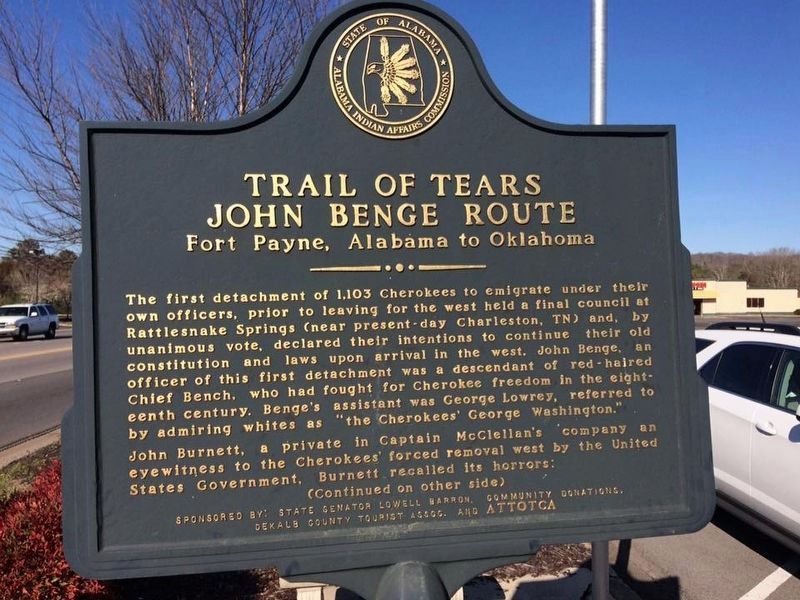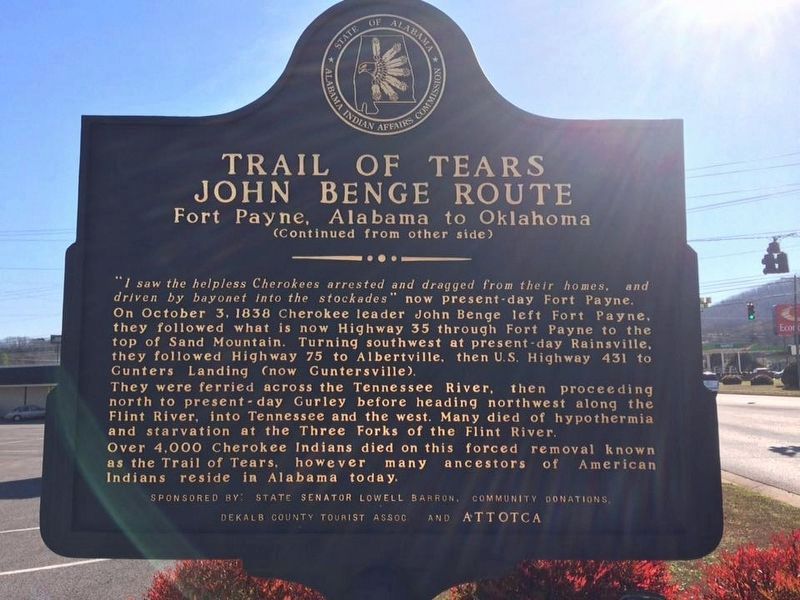Fort Payne in DeKalb County, Alabama — The American South (East South Central)
Trail of Tears
John Benge Route
— Fort Payne, Alabama to Oklahoma —
John Burnett, a private in Captain McClellan's company as an eyewitness to the Cherokees' forced removal west by the United States Government. Burnett recalled its horrors:
"I saw the helpless Cherokees arrested and dragged from their homes, and driven by bayonet into the stockades" now present-day Fort Payne. On October 3, 1838, Cherokee leader John Benge left Fort Payne, they followed what is now Highway 33 through Fort Payne to the top of Sand Mountain. Turning southwest at present-day Rainesville, they followed Highway 75 to Albertville, then U.S. Highway 431 to Gunters Landing (now Guntersville).
They were ferried across the Tennessee River, then proceeding north to present-day Gurley before heading northwest along the Flint River, into Tennessee and west. Many died of hypothermia and starvation at the Three Forks of the Flint River.
Over 4,000 Cherokee Indians died on this forced removal known as the Trail of Tears, however many ancestors of American Indians reside in Alabama today.
Erected by State Senator Lowell Barron, community donations, DeKalb County Tourist Assoc. and ATTOTCA; Alabama Indian Affairs Commission.
Topics and series. This historical marker is listed in this topic list: Native Americans. In addition, it is included in the Trail of Tears series list. A significant historical date for this entry is October 3, 1838.
Location. 34° 26.266′ N, 85° 45.152′ W. Marker is in Fort Payne, Alabama, in DeKalb County. Marker is at the intersection of Glenn Boulevard SW (Alabama Route 35) and Airport Road West, on the right when traveling west on Glenn Boulevard SW. Touch for map. Marker is at or near this postal address: 1503 Glenn Blvd SW, Fort Payne AL 35968, United States of America. Touch for directions.
Other nearby markers. At least 8 other markers are within 2 miles of this marker, measured as the crow flies. Fort Payne Cabin Historic Site (approx. 1.6 miles away); Main Street Historic District (approx. 1.7 miles away); Cherokee Indian Removal (approx. 1.7 miles away); Alabama (approx. 1.9 miles away); Whittler's Corner (approx. 1.9 miles away); Sequoyah (approx. 1.9 miles away); Wills Town Mission (approx. 1.9 miles away); Fort Payne’s Fort (approx. 1.9 miles away). Touch for a list and map of all markers in Fort Payne.
Credits. This page was last revised on May 12, 2022. It was originally submitted on February 8, 2018, by Debra Oliver of Jonesboro, Georgia. This page has been viewed 895 times since then and 90 times this year. Photos: 1, 2. submitted on February 8, 2018, by Debra Oliver of Jonesboro, Georgia. 3. submitted on May 9, 2022, by Duane and Tracy Marsteller of Murfreesboro, Tennessee. • Bernard Fisher was the editor who published this page.


